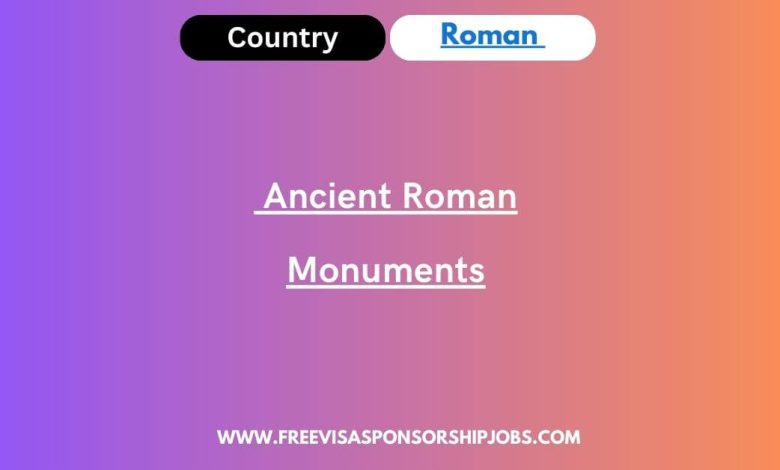Ancient Roman Monuments

What have the Romans ever done for us? Well, one of the most famous things about the Romans is their architecture. They gave building a lot of new ideas, like the arch, baked bricks, and using cement and concrete. The fact that so many Roman buildings are still standing shows how good their design was.
List of Ancient Roman Monuments:
Arch of Caracalla at Volubilis
In 211 AD, the marble Arch of Caracalla was built right in the middle of Volubilis to honor Emperor Caracalla and his mother, Julia Domna. The metal chariot on top of the arch and the Corinthian columns make it an impressive Roman building.
Roman Theatre of Merida
An engraving says that Agrippa, a general and friend of Emperor Augustus, ordered the Roman Theater of Merida to be built in 16 BC. The old theater could fit up to 6,000 people. In later centuries, the theater was fixed up a few times, and each time new architectural features and decorations were added. In the 1960s and 1970s, the building was fixed up to look the way it does now.
Lugo City Walls
Lugo, in the northwest of Spain, is the only city in Europe that still has all of its Roman walls. Along a circle of 71 towers, the walls reach a height of 10 to 15 meters (30-50 feet). The top walk goes all the way around the track and has ten gates.
Les Ferreres Aqueduct
Les Ferreres Aqueduct, also called Pont del Diable (which means “Devil’s Bridge”), was built to bring water from the Francoli River 15 kilometers (9 miles) south to the city of Tarragona. It probably comes from the time of Augustus, the first master of the Roman Empire. The canal is 249 meters long and stands as high as 27 meters. It had 25 arches at the top and 11 arches at the bottom.
Baths of Caracalla
The Baths of Caracalla were public baths, called thermae, that were built in Rome between 212 and 216 AD when Caracalla was emperor. The group of buildings was more like a recreation center than a group of pools. It had a public library and a wrestling school, and it could hold about 1,600 people for a swim. The baths were used until the 6th century when the Ostrogoths destroyed the hydraulic systems during the Gothic War by sacking the complex.

Valens Aqueduct
The Valens Aqueduct was finished in the year 368 AD when Valens was emperor of Rome. It is named after him. It was just one of the ends of an old system of aqueducts and canals. The whole system was over 250 kilometers (155 miles) long, making it the longest of its kind in ancient times. Several Ottoman Sultans fixed up the Valens Aqueduct, which was still Constantinople’s main water system in the Middle Ages.
Roman Theatre of Amman
During the time of Marcus Aurelius, in the second century AD, the Roman Theater of Amman was built. It is cut into the hillside and faces north so that onlookers don’t get too much sun. The theater had three levels. The rulers sat closest to the action, the troops sat in the middle, and the rest of the people watched from the top. Even though they were far from the stage, they could still hear the performers well because the theater was so steep.
Arch of Septimius Severus
Lucius Septimius Severus was the Roman Emperor from 193 until he died in 211. He was born in Leptis Magna. The people of Leptis may have started building as soon as their fellow citizens became emperors. In the middle of the arch, the emperor shakes hands with his two sons, Geta and Caracalla. Caracalla is shown as a tall young man, which suggests that the arch was probably finished in the early 200s.
Read More: Best Things to Do in Salamanca Spain
Arch of Titus
Domitian, the Roman Emperor, built the Arch of Titus in Rome in 82 AD, not long after his older brother Titus died. He did this to remember Titus’ victory in the Sack of Jerusalem in 70 AD. Since the 16th century, many imperial arches, like the Arc de Triomphe, have been made in the same style as the Arch of Titus.
Theatre of Side
The side became a part of the Roman province of Galatia in the year 25 BC. It did well as a trading center for olive oil and slaves. Roman ruins in Side are still in pretty good shape. They include a temple, a city gate, and an old theater that could hold between 15,000 and 20,000 people.
Timgad Arch
Trajan, the Roman Emperor, started a colony in North Africa called Timgad around the year 100 AD. Trajan’s Arch is a 39-foot-high arch at the west end of the town. It was partly fixed up in the year 1900. Sandstone was mostly what was used to build the arch.
Theatre of Sabratha
Around 500 BC, the Phoenicians built Sabratha as a trading post. During Roman rule, it was at its best as a place where goods from the interior of Africa could be sold along the coast. In the year 200 AD, the Theater of Sabratha was built. Italian researchers rebuilt the Roman building in the 1930s, so it looks like most of it is still there. There were about 5,000 seats in the theater, which had 25 exits.
Benefits of Ancient Roman Monuments:
- Historical Preservation: By serving as physical reminders of the past, ancient Roman monuments safeguard the heritage and history of the Roman civilization. By offering perspectives on the political, social, and economic dimensions of ancient Rome, they augment our comprehension of the course of human history.
- Cultural Identity: These architectural wonders are fundamental components of the cultural identity of Western civilization as well as Italy. They serve as representations of the cultural contributions and accomplishments of the ancient Romans across various domains, including architecture, engineering, art, and urban planning.
- Architectural Marvels: Roman architectural marvels, including but not limited to the Colosseum, the Pantheon, and the Roman Forum, are extraordinary structures. Architectural and building practices have been profoundly impacted by their design and construction methods for centuries, which have inspired subsequent architectural styles.
- Tourism and Economy: The ancient Roman monuments serve as significant points of interest for tourists, attracting visitors from various parts of the globe. This type of tourism considerably benefits the local and national economies by providing support to various types of businesses, including hotels, restaurants, and tour services.
- Education and Research: The investigation of Roman monuments affords students, historians, and archaeologists educational opportunities. Scholarly investigation into these edifices enhances our comprehension of the engineering methodologies, artistic movements, and social configurations that characterized ancient Rome.
- Undeniable Aesthetic Appeal: Roman monuments possess an aesthetic allure. The architectural splendor of the environs is enhanced by the artistry, craftsmanship, and meticulousness displayed in edifices such as the Roman Baths and the Arch of Constantine.
- Inspiration for Art and Literature: Monuments of the ancient Roman Empire have historically served as a wellspring of inspiration for philosophers, artists, and writers. Other artistic expressions, including literature, paintings, and sculptures, have been impacted by their ideas.
- Symbol of Endurance: The enduring nature of Roman monuments throughout the centuries serves as an indication of the robustness and resilience exhibited by Roman engineering and construction techniques. The enduring nature of Roman aqueducts and other structures serves as evidence of the long-lasting nature of ancient Roman infrastructure.
- Civic Pride: Local populations are imbued with a sense of civic pride through the presence of Roman monuments. They frequently serve as emblems of communal identity and wellsprings of pride among the local populace, facilitating a bond between contemporary inhabitants and their ancestral heritage.
- Global Heritage: Numerous Roman structures have received the esteemed designation of UNESCO World Heritage Sites, which further underscores their worldwide importance. The preservation of these entities is a collective obligation of the international community, underscoring their intrinsic worth to the entire human race.
Frequently Asked Questions:
-
What monuments did ancient Rome build?
Colosseum
Markets of Trajan
Pyramid of Cestius
baths of Caracalla -
What is the oldest monument in Rome?
Pantheon Temple: Oldest Building in Rome
-
Which is the famous monument in Rome?
The Pantheon, Sistine Chapel, and Roman Colosseum represent some of the most magnificent buildings in Rome.




